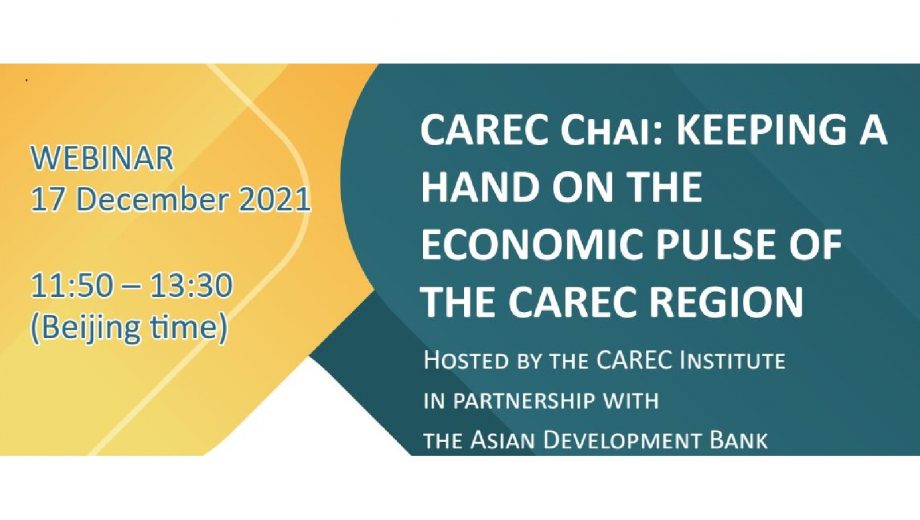CAREC Chai: Keeping a hand on the economic pulse of the CAREC region (and beyond)

On 17 December 2021, the CAREC Institute in collaboration with the ADB launched the first CAREC Chai webinar. This initiative aims at bringing together prominent speakers, on a regular basis, to discuss the trajectory of economic recovery from the COVID-19 pandemic in the CAREC region, the progress achieved, obstacles, and the outlook. The inaugural event was titled “CAREC Chai: Keeping a Hand on the Economic Pulse of the CAREC Region (and beyond).”
“The pandemic taught everyone to embrace, diversify and come together on a new journey to overcome new challenges. When countries align around a common objective through a regional cooperation mechanism, they can achieve more, even more than the period before the pandemic. Hence, the pandemic has shown how regional cooperation can be a desirable goal,” said the CAREC Institute Director Syed Shakeel Shah in his opening statement. He also noted that demand shocks have been replaced with supply shocks as inflationary pressures are building around the economies, and the global logistics crisis is adding another dimension to it as shipping costs are reaching unprecedented levels. Some economies, notably the PRC, were able to carry out modernization of logistics chains with enhanced use of artificial intelligence (AI) and digital technologies leading to quicker turnaround times. For others, the process was slow leading to significant delays.
Selim Çakir of the International Monetary Fund noted, inter alia, that overcoming vaccine hesitancy remains crucial, and sudden tightening of financial conditions in the US and other major economies could lead to capital outflows. In order to bolster growth, he recommended investing in youth and women, digitalization, adaptation to climate change, and transition to lower carbon dependence, also reducing informality in CAREC.
Dominik Peschel from the ADB PRC mission discussed economic developments in the PRC, including the recent slowdown in growth and investment and the dichotomy of moderate consumer price inflation and much higher producer price inflation.
Richard Pomfret of Adelaide University noted that recent price hikes and disruptions in ocean transport is a major competitive boon for the land transport across Euro-Asia, and that multiple corridors enhance competition, lower prices, and reduce scope for political interference. He also reasoned that the recent opening up of Uzbekistan and the improvement in diplomatic relations among Central Asian countries at the presidential level may result in improved conditions for cross-border trade and transit facilitation.
The CAREC Institute Chief Economist Hans Holzhacker discussed if CAREC’s post-COVID development returns to normal or enters a “new normal.” He noted that CAREC economic recovery is underway against the backdrop of an apparent overall slowdown in economic growth in the 2010s. Value added in services has been rising faster than GDP in most CAREC economies; that CAREC countries are vulnerable to commodity price fluctuations and decarbonization. His presentation raised important questions whether digitalization and other technological change can induce a further shift towards services (and which services) in the CAREC region or whether the opposite will take place thanks to new comparative advantages in agriculture and industry; to what extent will e-commerce and enhanced connectivity increase competition; to what extent CAREC (ex. the PRC) companies will cooperate with companies from outside the region; and what net effect can accelerated technological change bring on growth in the CAREC region.
This webinar invited several questions for future webinars to answer, namely what the implications might be from a potential COVID (Omicron variant) resurgence and resulting lockdowns in the PRC, what could be implications for other countries in CAREC from the PRC’s dual circulation strategy, implications of the recent reduction in the Belt and Road Initiative (BRI) investments for the CAREC region, if BRI and the EU’s new Global Gateway initiative can provide significant opportunities to further strengthen CAREC’s connectivity through investments in hard infrastructure, what will it take to improve “soft” infrastructure significantly, how climate change and decarbonization will affect regional connectivity, and whether Afghanistan can be a corridor to north-south connectivity under current circumstances and how it will be engaged by CAREC.